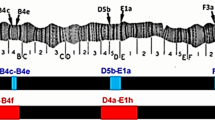Summary
When Drosophila melanogaster males coming from a class of strains known as inducer are crossed with females from the complementary class (reactive), a quite specific kind of sterility is observed in the F1 female progeny (denoted SF). The inducer chromosomes differ from the reactive chromosomes by the presence of a transposable element (called the I factor) that is responsible for the induction of this dysgenic symptom. In the germ line of dysgenic females, up to 100% of the reactive chromosomes may be contaminated, i.e. they acquire I factor(s) owing to very frequent replicative transpositions. A contaminated reactive stock was obtained by reconstructing the reactive genotype in the offspring of SF females and its kinetics of invasion by I elements was followed in the successive inbred dysgenic generations. The results show that the mean copy number of I elements increased very quickly up to the level of inducer strains and then stayed in equilibrium even though the dysgenic state was perpetuated by selection for SF sterility at every generation. The possible mechanisms of this copy number limitation are discussed.
Similar content being viewed by others
References
Alleman M, Freeling M (1986) The Mu transposable elements of maize: evidence for transposition and copy number regulation during development. Genetics 112:107–119
Anxolabéhère D, Benes H, Nouaud D, Périquet G (1987) Evolutionary steps and transposable elements in D. melanogaster: the missing RP type obtained by genetic transformation. Evolution, in press
Biémont C (1986) Polymorphism of the Mdg-1 and I mobile elements in Drosophila melanogaster. Chromosoma 93:393–397
Bouchard RA (1982) Moderately repetitive DNA in evolution. Int Rev Cytol 76:113–193
Bregliano JC, Kidwell MG (1983) In: Shapiro JA (ed) Mobile genetic elements. Academic Press, NY, pp 363–410
Brookfield JFY (1986) A model for DNA sequence evolution within transposable element families. Genetics 112:393–407
Bucheton A (1978) Non mendelian female sterility in Drosophila melanogaster: influence of ageing and thermic treatments. I-Evidence for a partly inheritable effect of these factors. Heredity 41:357–369
Bucheton A (1979a) Non mendelian female sterility in Drosophila melanogaster: influence of ageing and thermic treatments. II-Action of thermic treatments on the sterility of SF females and on the reactivity of reactive females. Biol Cell 34:43–50
Bucheton A (1979b) Non mendelian female sterility in Drosophila melanogaster: influence of ageing and thermic treatments. III-Cumulative effects induced by these factors. Genetics 93:131–142
Bucheton A, Bregliano JC (1982) The I-R system of hybrid dysgenesis in Drosophila melanogaster: heredity of the reactive condition. Biol Cell 46:123–132
Bucheton A, Picard G (1978) Non-mendelian female sterility in Drosophila melanogaster: hereditary transmission of reactivity levels. Heredity 40:207–223
Bucheton A, Paro R, Sang HM, Pélisson A, Finnegan DJ (1984) The molecular basis of I_R hybrid dysgenesis in Drosophila melanogaster: identification, cloning and properties of the I factor. Cell 38:153–163
Charlesworth B, Charlesworth D (1983) The population dynamics of transposable elements. Genet Res 42:1–27
Charlesworth B, Langley CH (1986) The evolution of self regulated transposition of transposable elements. Genetics 112:359–383
David J (1959) Etude quantitative du développement de la Drosophile élevée en milieu axénique. Bull Soc Biol France et Belgique 93:472–505
Engels WR (1983) The P family of transposable elements in Drosophila. Annu Rev Genet 17:315–344
Johnson RC, Reznikoff WS (1984) Copy number control of Tn5 transposition. Genetics 107:9–18
Kaplan N, Darden T, Langley CH (1985) Evolution and extinction of transposable elements in mendelian population. Genetics 109:459–480
Kostriken R, Morita C, Heffron I (1981) The transposon Tn3 encodes a site specific recombination system: identification of essential sequences, genes and the actual site of recombination. Proc Natl Acad Sci USA 78:4041–4045
Langley CH, Brookfield JFY, Kaplan N (1983) Transposable elements in mendelian populations. I-A theory. Genetics 104:457–471
Lavige JM (1986) Further data on the arrest of development of the embryos from SF females. Biol Cell 56:207–216
Lindsley DL, Grell EH (1968) Genetic variations of Drosophila melanogaster. Carnegie Institution of Washington publication no. 627
O'Hare K (1985) The mechanism of control of P element transposition in Drosophila melanogaster. Trends Genet 1:250–254
Pardue ML, Gall JG (1975) In: Prescott D (ed) Methods in cell biology. Academic Press, NY, pp 1–16
Pélisson A (1981) The I-R system of hybrid dysgenesis in Drosophila melanogaster: are I factor insertions responsible for the mutator effect of the I-R interaction? Mol Gen Genet 183:123–129
Picard G (1976) Non mendelian female sterility in Drosophila melanogaster: hereditary transmission of I factor. Genetics 83:107–123
Picard G (1978a) Non mendelian female sterility in Drosophila melanogaster: sterility in stocks derived from the genotypically inducer or reactive offspring of SF and RSF females. Biol Cell 31:245–254
Picard G (1978b) Non mendelian female sterility in Drosophila melanogaster: further data on chromosomal contamination. Mol Gen Genet 164:235–274
Picard G (1979) Non mendelian female sterility in Drosophila melanogaster: principal characteristics of chromosomes from inducer and reactive origin after chromosomal contamination. Genetics 91:455–471
Robertson DS (1983) A possible dose dependent inactivation of Mutator (Mu) in maize. Mol Gen Genet 191:86–90
Rose RR, Doolittle WF (1983) Molecular mechanisms of speciation. Science 220:157–162
Rubin GM, Spradling AC (1981) Drosophila genome organization: conserved and dynamic aspects. Annu Rev Genet 15:219–264
Sang HM, Pélisson A, Bucheton A, Finnegan DJ (1984) Molecular lesions associated with white gene mutations induced by I-R hybrid dysgenesis in Drosophila melanogaster. EMBO J 3:3079–3085
Schwartz D (1984) Analysis of the Ac element dosage effect in maize. Mol Gen Genet 196:81–86
Shapiro JA (1983) Mobile genetic elements. Academic Press, NY
Simmons R, Kleckner N (1983) Translational control of IS10 transposition. Cell 34:683–691
Syvanen M (1984) The evolutionary implications of mobile genetic elements. Annu Rev Genet 18:271–293
Author information
Authors and Affiliations
Additional information
Communicated by B.J. Kilbey
Rights and permissions
About this article
Cite this article
Pelisson, A., Bregliano, J.C. Evidence for rapid limitation of the I element copy number in a genome submitted to several generations of I-R hybrid dysgenesis in Drosophila melanogaster . Mol Gen Genet 207, 306–313 (1987). https://doi.org/10.1007/BF00331594
Received:
Issue Date:
DOI: https://doi.org/10.1007/BF00331594




